Do you have a question about the Schumacher 200-30 and is the answer not in the manual?
Essential safety guidelines for handling and using lead-acid batteries and chargers.
Specifies charger use for lead-acid batteries only, not dry-cell types.
Emphasizes using manufacturer-recommended attachments to prevent hazards.
Instructs to pull by the plug, not the cord, to prevent damage.
Mandates immediate replacement of damaged cords or plugs.
Requires professional inspection and repair for damaged chargers.
Advises against self-disassembly; use qualified professionals for repair.
Stresses unplugging the charger before maintenance or cleaning.
Guidelines for using extension cords, including wire size and condition.
Requires charging in a well-ventilated area to prevent gas buildup.
Positions charger away from the battery to minimize exposure to gases.
Warns against exposing the charger to adverse weather conditions.
Prohibits charging frozen batteries; thaw before charging.
Prevents battery acid from dripping onto the charger during service.
Discourages placing a battery directly on top of the charger.
Avoids placing the charger above the battery due to corrosive gases.
Warns against touching charger clips together when energized.
Mandates wearing eye and clothing protection when handling batteries.
Recommends having someone nearby for assistance during battery work.
Advises keeping water and soap ready for battery acid exposure.
Warns against touching eyes due to acid particles; immediate medical attention.
Advises removing metal jewelry to prevent short circuits and burns.
Caution against dropping metal objects on the battery to prevent sparks.
Reiterates the need for open, well-ventilated areas for charger operation.
Prohibits smoking or sparks near batteries due to explosive gases.
Ensuring the charger is properly grounded to reduce electric shock risk.
Guidance on using temporary adapters for grounded outlets.
Verify the battery voltage (6V or 12V) before charging.
Instructions for cleaning battery terminals and avoiding corrosion.
Add distilled water to cells if needed to purge excess gas.
Study specific battery manufacturer guidelines for charging.
Use a fan or cardboard to ensure good ventilation around the battery.
Procedure for removing the battery, disconnecting grounded terminal first.
Marine batteries must be removed and charged on shore.
Prevents battery gases from damaging the charger.
Avoid battery acid contact with the charger during filling.
Do not operate the charger in a closed or restricted area.
Prohibits placing the battery directly on top of the charger.
Proper positioning of cords to avoid damage from moving engine parts.
Advise staying clear of hazardous moving parts in the engine compartment.
How to identify positive and negative battery posts based on markings.
Identify which battery post is connected to the vehicle chassis.
Connect positive clip to battery, negative clip to chassis for negative-grounded vehicles.
Connect negative clip to battery, positive clip to chassis for positive-grounded vehicles.
Twist or rock clips to ensure a solid connection and reduce sparking.
Select amperage and follow steps in Battery Charger Section K.
Remove charger clips from chassis and battery pole in order.
Final steps involve cleaning and storing the battery charger.
How to identify positive and negative battery posts based on markings.
Connect a 24-inch insulated cable to the negative battery post.
Connect the red charger clip to the positive battery post.
Connect the black charger clip to the free end of the auxiliary cable.
Select charging amperage and follow steps in Battery Charger Section.
Remove clips from the negative cable end and positive post.
Final steps involve cleaning and storing the battery charger.
Description of each switch position for charging and engine start.
Ensures battery voltage matches the selected charge rate.
Explanation of the dual self-reset circuit breaker system.
Explains how the ammeter indicates charging current and battery status.
Charging procedure for cold batteries, noting rate adjustments.
How to identify and handle batteries with shorted cells.
Procedure for charging deeply discharged lead-calcium batteries.
Connect the charger to the battery with the charger unplugged.
Set the selector switch to the 12-volt Engine Start position.
Crank the engine, following duty cycle for cranking attempts.
Instructions for repeated cranking attempts if the engine fails to start.
Unplug charger and disconnect clips after the engine starts.
Warning against starting an engine without a battery connected.
Calculate the battery's ampere hour rating using hydrometer or tester.
Formula to determine required charge time based on battery capacity and charger setting.
Ideal specific gravity for a battery in good condition is between 1.25 and 1.28.
Bubbles indicate 80-85% charge; vigorous bubbling means nearing full charge.
Ensure electrolyte level is correct before charging.
Ensure the charge rate switch is in the OFF position before proceeding.
Plug the charger into the AC outlet after connecting to the battery.
Select the appropriate charge rate based on the battery type and size.
Chargers require regular monitoring to prevent overcharging.
Reference chart for battery sizes, ratings, and recommended charging times.
Essential safety guidelines for handling and using lead-acid batteries and chargers.
Specifies charger use for lead-acid batteries only, not dry-cell types.
Emphasizes using manufacturer-recommended attachments to prevent hazards.
Instructs to pull by the plug, not the cord, to prevent damage.
Mandates immediate replacement of damaged cords or plugs.
Requires professional inspection and repair for damaged chargers.
Advises against self-disassembly; use qualified professionals for repair.
Stresses unplugging the charger before maintenance or cleaning.
Guidelines for using extension cords, including wire size and condition.
Requires charging in a well-ventilated area to prevent gas buildup.
Positions charger away from the battery to minimize exposure to gases.
Warns against exposing the charger to adverse weather conditions.
Prohibits charging frozen batteries; thaw before charging.
Prevents battery acid from dripping onto the charger during service.
Discourages placing a battery directly on top of the charger.
Avoids placing the charger above the battery due to corrosive gases.
Warns against touching charger clips together when energized.
Mandates wearing eye and clothing protection when handling batteries.
Recommends having someone nearby for assistance during battery work.
Advises keeping water and soap ready for battery acid exposure.
Warns against touching eyes due to acid particles; immediate medical attention.
Advises removing metal jewelry to prevent short circuits and burns.
Caution against dropping metal objects on the battery to prevent sparks.
Reiterates the need for open, well-ventilated areas for charger operation.
Prohibits smoking or sparks near batteries due to explosive gases.
Ensuring the charger is properly grounded to reduce electric shock risk.
Guidance on using temporary adapters for grounded outlets.
Verify the battery voltage (6V or 12V) before charging.
Instructions for cleaning battery terminals and avoiding corrosion.
Add distilled water to cells if needed to purge excess gas.
Study specific battery manufacturer guidelines for charging.
Use a fan or cardboard to ensure good ventilation around the battery.
Procedure for removing the battery, disconnecting grounded terminal first.
Marine batteries must be removed and charged on shore.
Prevents battery gases from damaging the charger.
Avoid battery acid contact with the charger during filling.
Do not operate the charger in a closed or restricted area.
Prohibits placing the battery directly on top of the charger.
Proper positioning of cords to avoid damage from moving engine parts.
Advise staying clear of hazardous moving parts in the engine compartment.
How to identify positive and negative battery posts based on markings.
Identify which battery post is connected to the vehicle chassis.
Connect positive clip to battery, negative clip to chassis for negative-grounded vehicles.
Connect negative clip to battery, positive clip to chassis for positive-grounded vehicles.
Twist or rock clips to ensure a solid connection and reduce sparking.
Select amperage and follow steps in Battery Charger Section K.
Remove charger clips from chassis and battery pole in order.
Final steps involve cleaning and storing the battery charger.
How to identify positive and negative battery posts based on markings.
Connect a 24-inch insulated cable to the negative battery post.
Connect the red charger clip to the positive battery post.
Connect the black charger clip to the free end of the auxiliary cable.
Select charging amperage and follow steps in Battery Charger Section.
Remove clips from the negative cable end and positive post.
Final steps involve cleaning and storing the battery charger.
Description of each switch position for charging and engine start.
Ensures battery voltage matches the selected charge rate.
Explanation of the dual self-reset circuit breaker system.
Explains how the ammeter indicates charging current and battery status.
Charging procedure for cold batteries, noting rate adjustments.
How to identify and handle batteries with shorted cells.
Procedure for charging deeply discharged lead-calcium batteries.
Connect the charger to the battery with the charger unplugged.
Set the selector switch to the 12-volt Engine Start position.
Crank the engine, following duty cycle for cranking attempts.
Instructions for repeated cranking attempts if the engine fails to start.
Unplug charger and disconnect clips after the engine starts.
Warning against starting an engine without a battery connected.
Calculate the battery's ampere hour rating using hydrometer or tester.
Formula to determine required charge time based on battery capacity and charger setting.
Ideal specific gravity for a battery in good condition is between 1.25 and 1.28.
Bubbles indicate 80-85% charge; vigorous bubbling means nearing full charge.
Ensure electrolyte level is correct before charging.
Ensure the charge rate switch is in the OFF position before proceeding.
Plug the charger into the AC outlet after connecting to the battery.
Select the appropriate charge rate based on the battery type and size.
Chargers require regular monitoring to prevent overcharging.
Reference chart for battery sizes, ratings, and recommended charging times.
| Brand | Schumacher |
|---|---|
| Model | 200-30 |
| Category | Battery Charger |
| Language | English |
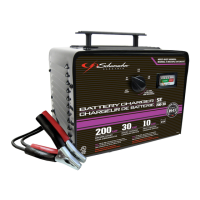
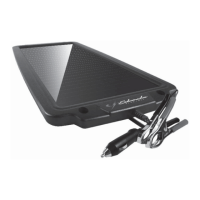
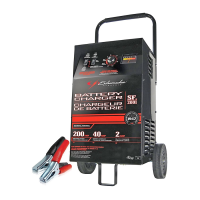
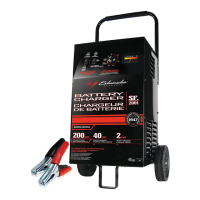





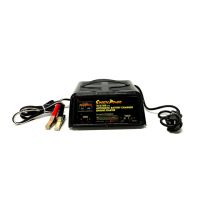
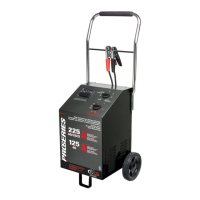

